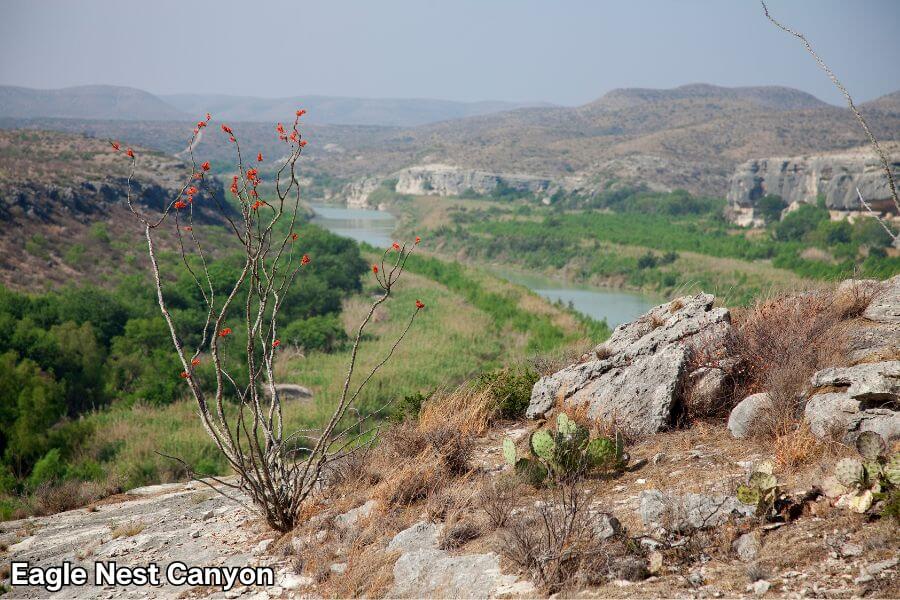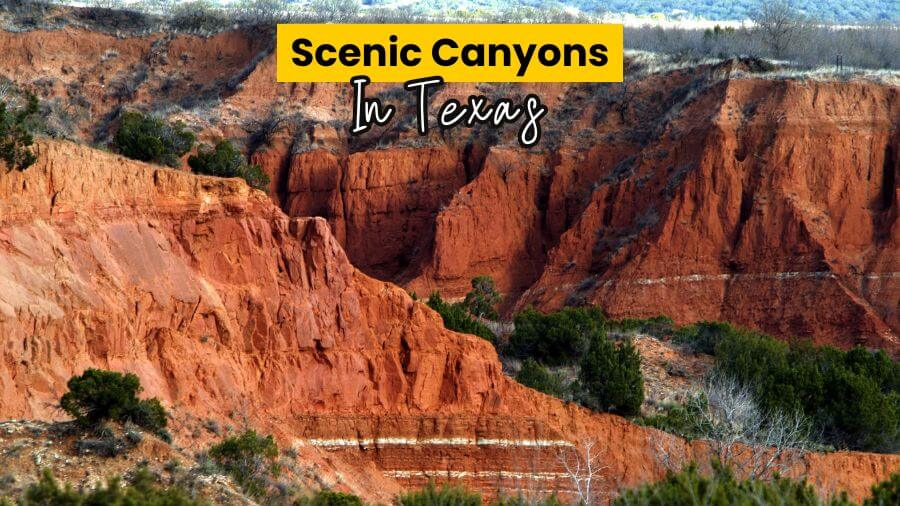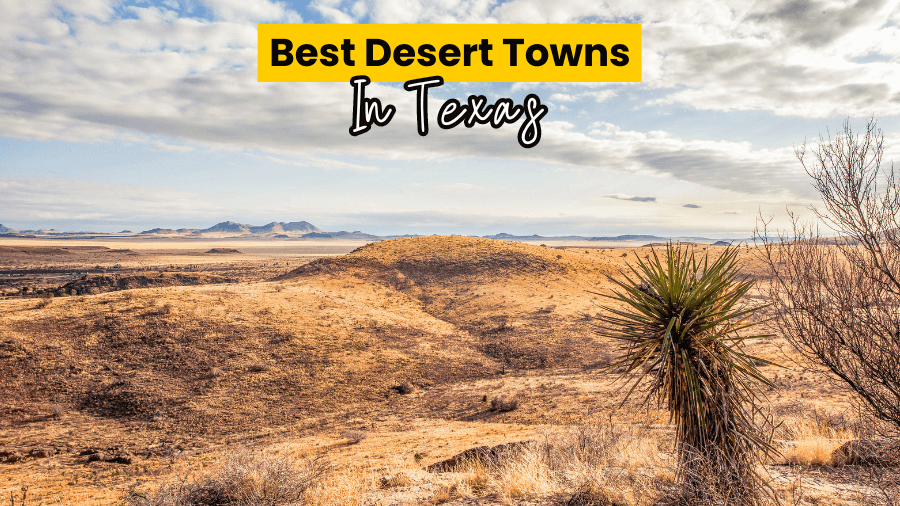Are you ready for an unforgettable adventure?
Texas isn’t just about cowboy boots, country music and big cities.
Hidden in the heart of this vast state are some of the most breathtaking canyons you’ve ever seen.

And guess what?
You can actually hike through them!
Whether you’re an experienced hiker or more of a beginner, these ten scenic canyons offer something for everyone.
Trust me, you won’t want to miss these stunning trails!
1. Palo Duro Canyon

Palo Duro Canyon, located in the Texas Panhandle near Amarillo and Canyon, is often called “The Grand Canyon of Texas” due to its impressive size and stunning geological features.
This canyon stretches about 120 miles long and reaches depths of up to 800 feet, showcasing multicolored rock layers and steep mesa walls.
One of the most popular hikes is the Lighthouse Trail, a 6-mile round trip that leads to a famous rock formation that resembles a lighthouse.

The trail is doable for most people and is rated as ‘moderate’ but it’s worth noting that it does have a challenging final ascent.
For those seeking more of a challenge, the Rock Garden Trail offers a steep and rugged 5-mile round trip with breathtaking views.
Along the way, you can expect to see a variety of wildlife, including deer and wild turkeys, as well as beautiful wildflowers in the spring.
2. McKittrick Canyon

McKittrick Canyon, located in the Guadalupe Mountains of West Texas, is a hidden gem known for its stunning fall foliage and diverse plant life.
This canyon is a unique riverside oasis located in the middle of the Chihuahuan Desert, making it a must-visit for anyone who loves nature.
The Pratt Cabin Trail is a 4.8-mile round trip that starts at the visitor center and follows a dry stream bed, gradually transitioning to lush vegetation as you ascend.

Hikers can expect to see stunning maple and hardwood trees, which are especially breathtaking in the fall, alongside desert plants like yucca and agave.
The trail ends at the historic Pratt Cabin which was built by a former geologist who donated the land to the National Park Service.
As you hike, you’ll cross the stream several times and may spot wildlife such as deer and various bird species.
3. Santa Elena Canyon

Santa Elena Canyon, located in Big Bend National Park in southwestern Texas, is a breathtaking natural wonder known for its towering cliffs that rise up to 1,500 feet.
This canyon is carved by the Rio Grande which has created a dramatic and picturesque landscape visible from miles away.
The Santa Elena Canyon Trail is a short but rewarding hike as it spans just 0.8 miles one way, making it doable for most people.

The trail begins at the end of Ross Maxwell Scenic Drive and includes a steep ascent followed by a descent to the river’s edge.
Along the way, you’ll be treated to stunning views of the canyon walls and the serene river below.
The hike is relatively easy, but it can be blocked when Terlingua Creek floods, so it’s best to check conditions before you go.
4. Seminole Canyon

Seminole Canyon, located near Comstock in Val Verde County, is a hidden gem filled with ancient history and natural beauty.
This state park is famous for its ancient Native American pictographs which date back thousands of years and offer a glimpse into the lives of early canyon dwellers.
One of the most popular hikes is the Canyon Rim Trail, a 4-mile trek that provides breathtaking views of the Rio Grande and the rugged canyon landscape.

For a deeper dive into history, join a guided tour to the Fate Bell Shelter where you can see some of North America’s oldest Native American pictographs.
The hike to Fate Bell Shelter is fairly rugged but the incredible rock art makes it worth the effort.
Along the trails, you might be able to spot wildlife and unique desert plants that you can’t see anywhere else.
5. Caprock Canyons

Caprock Canyons, located in the Texas Panhandle near Quitaque, is a stunning state park known for its vibrant red rocks and the official Texas State Bison Herd.
This park offers nearly 90 miles of trails, ranging from easy to challenging, making it a paradise for hikers, bikers and horseback riders.
One popular hike is the Eagle Point Trail, a 2-mile trek that leads you to the unique Natural Bridge rock formation.

For a more challenging hike, try the Haynes Ridge Overlook Trail which features steep climbs and breathtaking views of the canyon.
As you walk along the trails, you might encounter bison roaming freely.
The park also features the historic Clarity Tunnel which is home to a large colony of Mexican free-tailed bats.
6. McKelligon Canyon

McKelligon Canyon is located on the southeastern side of the Franklin Mountains in El Paso.
Known for its rock climbing, hiking, running, walking and biking, this canyon offers something for pretty much everyone.
One of the most popular trails is the Ron Coleman Trail which is a challenging hike that rewards you with stunning views of the surrounding desert landscape.
The trailhead starts at the end of McKelligon Canyon Road and the hike can take a few hours so be prepared for a good workout.
Besides hiking, the canyon is also home to a 1,503-seat amphitheater where you can catch the play ‘Viva El Paso!’ during the summer.
The canyon’s unique terrain, which is filled with many crevices and cracks, makes it a favorite spot for rock climbers.
7. Mariscal Canyon
Mariscal Canyon, located in the heart of Big Bend National Park, is a hidden gem known for its remote beauty and towering limestone cliffs.
The Mariscal Rim Trail is a 6.5-mile round trip hike that offers breathtaking views of the canyon and the surrounding desert.
To reach the trailhead, you’ll need a high-clearance vehicle due to the rough and rugged terrain.
The hike starts off easy but becomes steep and challenging as you ascend to the rim, where you’ll be rewarded with stunning views of the park and the Rio Grande.
Along the way, you might be able to spot unique desert plants like the rare silverspine cholla.
Be sure to bring plenty of water and start early to avoid the intense heat as there’s no shade on the trail.
8. Boquillas Canyon

Boquillas Canyon, located in Big Bend National Park, is the longest and deepest canyon in the entire park, with limestone walls rising up to 1,200 feet.
The Boquillas Canyon Trail is a 1.4-mile round trip hike that takes you to the edge of the Rio Grande and offers stunning views of the canyon’s entrance.
The trail starts at the end of Boquillas Canyon Road and includes a short climb before descending to the river.

Along the way, you might spot ancient fossils and prehistoric grinding holes that were once used by indigenous people.
The hike is relatively easy but it’s important to bring plenty of water and sun protection as the Texas heat can be intense.
The serene river and towering canyon walls make this a perfect spot for photography, especially at sunset.
9. Canyon Lake Gorge

Canyon Lake Gorge, located in Comal County near San Antonio, is a fascinating geological wonder created by a massive flood in 2002.
This 64-acre gorge was carved out in just a few days and exposed ancient limestone, fossils and even dinosaur footprints that are over 100 million years old.
The main trail is around a mile long which makes it an easy hike for most visitors but it’s packed with incredible sights.
Guided tours are available and typically last about three hours, providing in-depth information about the gorge’s history and geology.
Along the trail, you’ll see waterfalls, springs and unique rock formations that tell the story of the Earth’s past.
10. Eagle Nest Canyon

Honorable Mention
Eagle Nest Canyon, also known as Mile Canyon, is located just downstream from Langtry and is a tributary of the Rio Grande.
This canyon is famous for its archaeological history, including sites like Bonfire Shelter where ancient Native Americans conducted bison jumps.
Although the canyon itself is not open to public hiking, it can be viewed from nearby areas which offer a glimpse into its fascinating past.

The surrounding region is actually part of the Lower Pecos Canyonlands Archeological District due to its important history.
Eagle Nest Canyon is approximately one mile long and its name comes from a pair of golden eagles that nested nearby.
You can explore the nearby Langtry area and enjoy scenic views of the canyon from designated lookout points.
While you can’t hike through the canyon itself, the area’s historical significance and natural beauty make it a must-see destination in Texas.
Related Posts



